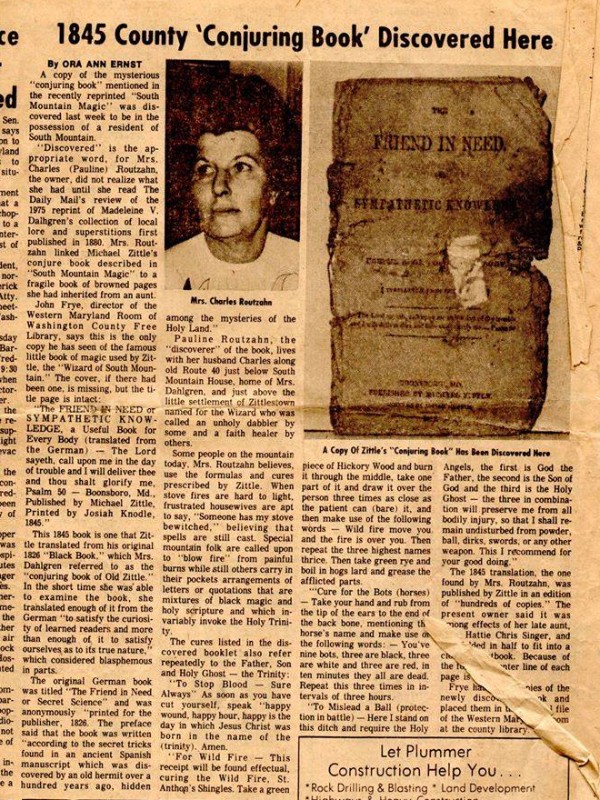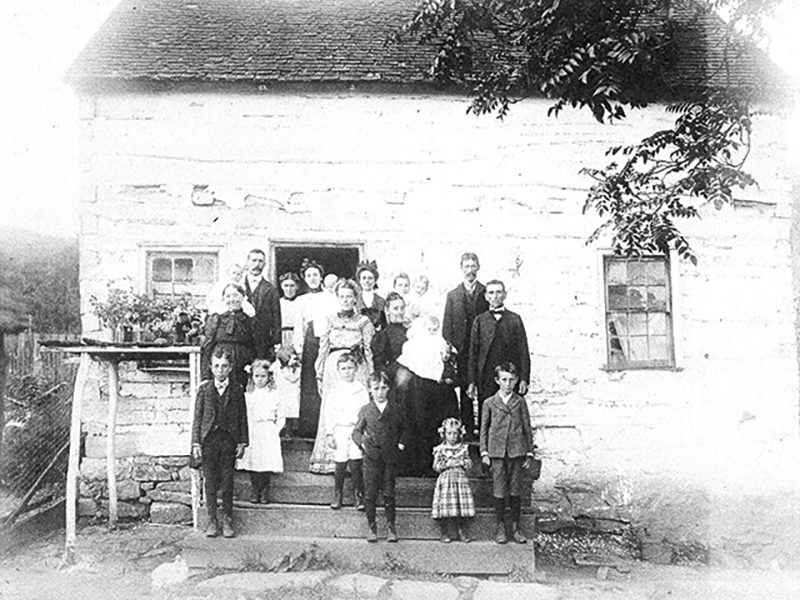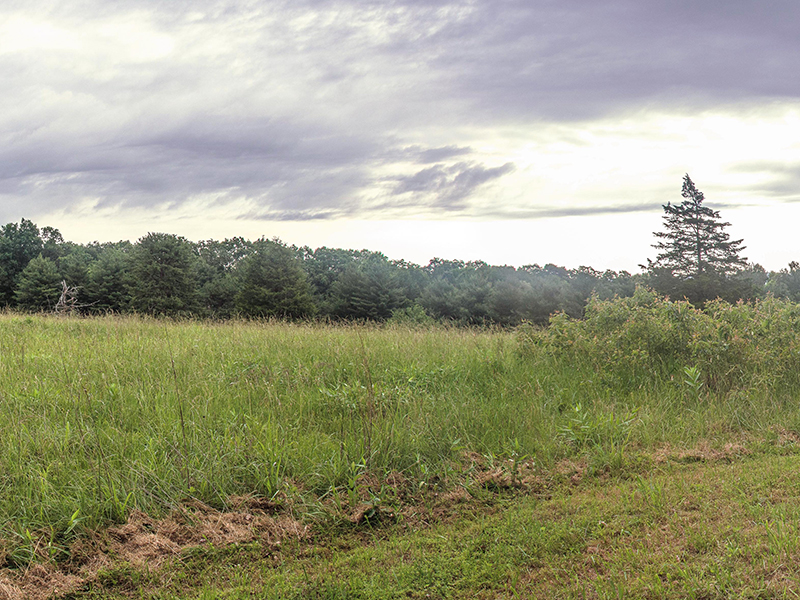On this week’s PreserveCast, we’re taking a departure from our normal programming to bring you a tale of old – a tale told here in the foothills, scarps and hillocks of the Appalachians.
In these blue hills of Maryland, as the chill of autumn arrives and we approach All Hallows Eve, we’re talking wizards, spells and sorcery.
Watch the Illustrated Reading
“In winter’s tedious nights, sit by the fire with good old folks, and let them tell thee tales of woeful ages, long ago” – William Shakespeare
RESEARCH, WRITING, AND DRAMATIC READING BY NICHOLAS REDDING
VIDEO BY SARAH PATARINI
Normally, on PreserveCast, we interview an expert in their given field – but this week – we’re telling our own tales and uncovering the story of Michael Zittle – the Wizard of South Mountain.
When it comes to wizards, you might be familiar with Merlin, Harry Potter, or perhaps even the Washington basketball team, but today’s wizard is a man named Michael Zittle who was born in Maryland in 1798, likely in a cabin somewhere along the spine of South Mountain. South Mountain is a part of the long line mountain chain which stretches from southern Pennsylvania all the way to southwestern Virginia and beyond.
Collectively, these mountains form many pleasant valleys – including the Great Shenandoah Valley of Virginia – which in the eighteenth and nineteenth century was a highway for Scots-Irish and German immigrants departing Pennsylvania and heading south. Today, with Route 11 and Interstate 81, it remains a major north-south thoroughfare. Along this early, internal immigration route, some travelers stopped along the way and made their home in the foothills and rough hillsides where cheap land was plentiful. It was here that the Zittles concluded their passage and built into the steep hillsides and where Michael Zittle was born in 1798.

The Zittle Family of South Mountain, MD. Photo from the Boonsbourough Museum of History.
Today, the area where Michael was born is fittingly known as Zittlestown, just a few miles up the road from Boonsboro which itself was formally established in 1792 by George and William Boone, cousins to the more famous Daniel Boone. In 1798, this entire region was becoming more settled and a far less wild part of the State of Maryland than it had been just thirty or forty years before – yet the misty mountains which served as a backdrop to this agricultural oasis were still shrouded in mystery and legend.
Much of what we know of Michael Zittle and the lore of South Mountain comes from Madeline Vinton Dahlgren, a 19th-century author, tavern keeper, anti-suffragist, and owner of the still-operational South Mountain Inn. In 1882, Dahlgren published, “South Mountain Magic: Tales of Old Maryland.” It was in this volume, that Dahlgren devoted numerous pages to the haunts, witches and wizards of these mountains. Dahlgren’s chronicles have formed some of the best-written accounts of the early folklore of the area, much of which would have been lost due to the dying tradition oral of storytelling.
Among the many unique stories she documented, some of the most famous include the Great Black Dog, a beast resembling a huge dog with large paws and an ugly red mouth known to terrify travelers; as well as the will-o’-the-wisp, sometimes known as the “Jack with a lantern” – a ghostly illumination known to arise in the hills and valleys of the mountain range. Much of the book is dedicated to describing these haunts and legends. After recounting these stories, Dahlgren goes on to describe the unique witchcraft and sorcery known to these hills; from the bush meetings of a sect of secretive Luciferian worshippers to wizardry and superstitious spells.
According to Dahlgren, many of the people who inhabited these hills believed in cures, hexes and superstition as a way of solving some of life’s most perplexing challenges and diseases. One spell documented in the book involved curing the “Go-Backs,” the name local settlers gave to children who failure to grow at a rate considered normal.
Dahlgren explained the local cure for the “Go-Backs” in detail, “This very retrogressive name is given to a sort of atrophy which often attacks children crowded in these huts, and produces a state of inanition or wasting away. For this sickness the following is considered a famous remedy, and is a real secret, which makes it all the more delightful to tell:
To cure the “Go-Backs” take two strings . . . with one string measure the patient from the crown of the across head to the tip of the toes, while the other string must be used in this way: Extend the arms in the form of a cross, and measure from tips of fingers. This second measurement has a double purpose, and is used as a diagnostic of the disease, namely, if the patient measures more crosswise than lengthwise, it is for certain the “abnehmen.” This is the secret name for “Go-Backs.”
After the measurement, grease the patient three times, well down the breastbone and on the ribs, using the two thumbs for this manipulation; and, while you grease, keep saying these words three times in the three Highest Names, “Abnehmen, depart.” This done, take the door of the room off its hinges, and twist one of the two strings, each on a hinge. Then, rehang the door, and when the action of the door shall wear these strings by the ordinary course of opening and shutting, the child will be cured.”
In addition to documenting local faith healing and superstitions, Dahlgren purportedly once gazed upon the legendary black spellbook owned by Michael Zittle, Jr. who she referred to as “the High Priest of all this evil practice.”
Dahlgren explained, “He was resorted to by hundreds of people from all the country round about South Mountain, and even from a distance, many of whom went away in the belief that they had been cured; and they may have been so.”
Of his black book of spells, Dahlgren continued, “We have seen the original “Conjuring Book” of Old Zittle. It is in German, and we have made a rude translation of portions of its sibylline leaves, quite enough of it, we trust, to satisfy the curiosity of our learned readers, and more than enough of it to satisfy ourselves as to its true nature.”
The spells which Dahlgren reviewed dealt with many afflictions – from thievery to fevers to stopping bleeding. Dahlgren explained that the first four conjurings or spells in Zittle’s book all dealt with the return of stolen or lost property. The first few of Zittle’s spells which Dahlgren recorded were as follows:
How One may compel a Thief or Thieves to restore Stolen Property. “O thief down what thou hast stolen and go away, in Satan’s name, in whose name thou hast taken my property.” How to proceed when a Thief or Thieves have stolen a Horse “Take the pitchfork and stick where the horse stood. Call the horse by name, and say: “I trample thee, I stick thee, I bite thee. Thou shalt come back and thou shalt turn the thief’s hand quickly, even as the wind or the fish that swim in the water or the birds that fly in the woods, or else thou shalt lie low under the sod. Come quick and be swift.”
Zittle, according to local historians, did not charge for these services or spells – but as demand for his work eventually became overwhelming he eventually decided to publish a book of spells as a way to cash-in on his abilities. Boonsboro printer Josiah Knodle published the book in 1845 under the title, “A Friend in Need; Or, Secret Science.” The book opened with the passage from Psalm 50: “Call upon Me in the day of trouble; I will deliver you, and you shall glorify Me.” Unfortunately, according to legend, after publication of the book Zittle lost his powers as a result of trying to commoditize his supernatural powers.
Impoverished by his poor choice, Zittle then attempted to charge for his services. Dahlgren explained that. “Being old and very poor, [Zittle] was persuaded to ask a fee, and when he did so, he had “bad luck.” The 1870 census listed the wizard’s age as 71, his occupation as “day laborer,” and his property value below that of any of his neighbors. It is said that he expired in great agony of soul.”
In the 1950s, another author, George Wetzel reviewed the story of Zittle and cast him in a new light – suggesting that Dahlgren, a staunch Roman Catholic had been too harsh on Zittle for his unusual ways and seemingly pagan practices. Zittle, in the words of George Wetzel was,
“Actually . . . a sort of faith healer . . . and if his magic book helped in his cures, it was a species of white magic, not black. Mrs. Dahlgren therefore has mistakenly characterized a good and kindly man as an unholy dabbler and a humbug.”
Boonsboro legend and local historian Doug Bast explained that this type of Zittle-ish healing and conjuring continued for many generations – well into the 20th century when Bast’s own father was said to be suffering from “the go-backs.” The healing was performed, and whether by nature or consequence, Bast’s father eventually thrived.

“Conjuring Book” found.
Incredibly, in 1975, one of Zittle’s published spell books was found in a local home by Ms. Pauline Routzhan who lived just below the South Mountain Inn once owned by Madeline Vinton Dahlgren. In a newspaper article chronicling the find, Ms. Routzhan, who found the book, explained that “Some people on the mountain today use the formulas and cures prescribed by Zittle. When [for example] stove fires are hard to light, frustrated housewives are apt to say, “someone has my stove bewitched,” believing that spells are still cast. Special mountain folk are called upon to “blow fire” from painful burns while still others carry in their pockets arrangements of letters or quotations that are mixtures of black magic and holy scripture and which invariably invoke the holy trinity.”
Then, some years later the original spell book was also found. Today, both books can be viewed at the Boonsboro Museum of History, a passion project of historian Doug Bast that is now in the planning phases of becoming a professionally curated and administered museum.
And not far from the museum, in a quiet cluster of Zittle family tombstones, the Wizard of South Mountain lies buried under a simple headstone. No mention of wizardry or spells adorns his grave but his legend and sorcery lives on in the hearts and minds of all who venture a visit to South Mountain.

Boonsboro Inn. Photo from Boonsboro Historical Society.
Today, thanks to the work of preservationists, many of the landscapes, towns and places associated with today’s story have been preserved for future generations. South Mountain itself is a major preservation victory – with tens of thousands of acres protected for nature and history. A state park protects large swaths of the landscape, which eventually became the site of a major Civil War battle in 1862 and the Appalachian Trail, a unit of the National Park Service, runs along the spine of the mountain, nearly mid-point in the trail’s Maine to Georgia length. Many homes have been lovingly restored and towns like Boonsboro are listed on the National Register of Historic Places for their long connection to the early history of the state and the national road which cuts through the center of town making it a major stop along America’s first federally funded road. And, today, Preservation Maryland, which powers PreserveCast, is working to help increase tourism and visitation to South Mountain. The organization recently concluded a first of its kind study which laid the groundwork for an in-progress rebranding and signage planning project – all aimed at increasing awareness and building support for the preservation of this place.
As Madeline Vinton Dahlgren began her book with an introduction to “Thoughts on the Occult,” so will we conclude this special, spellbinding episode of PreserveCast. Dahlgren offered that,
“Everyone, no matter how prejudiced or realistic, must admit that the occult has in all ages attracted the attention of investigating minds, so that it cannot be considered as any evidence of weak judgment, or want of logical perception, to admit surprising facts, the causes of which cannot be perceived. Rather, indeed, it is the exception when we can clearly trace cause and effect in the arcana of nature.”


